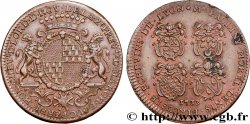fjt_461507 - LYONNAIS - CONSULATE OF LYON Jeton Br 30, Barthélemy Terrasson n.d.
Not available.
Item sold on our e-shop (2021)
Price : 150.00 €
Item sold on our e-shop (2021)
Price : 150.00 €
Type : Jeton Br 30, Barthélemy Terrasson
Date: (1729)
Date: n.d.
Metal : silver
Diameter : 30 mm
Orientation dies : 6 h.
Weight : 8,51 g.
Edge : lisse
Coments on the condition:
Très bel exemplaire avec une usure régulière. Patine marron
Catalogue references :
Obverse
Obverse legend : N. BARTHELEMY. TERRASSON. ECHEVIN. D. LYON..
Obverse description : Écu ovale aux armes de Barthélemy Terrasson, placé sur un cartouche, timbré d’un casque taré de face, orné de lambrequins et ayant pour cimier trois plumes.
Reverse
Reverse description : Écusson ovale aux armes de la Ville, placé sur un cartouche que soutient une console et qui a pour tenants les figures allégoriques nues et debout du Rhône et de la Saône laissant échapper l’eau de leurs urnes.
Commentary
Les armes de Barthélemy Terrasson portent d’azur au chevron d’argent et un soleil d’or en pointe.








 Report a mistake
Report a mistake Print the page
Print the page Share my selection
Share my selection Ask a question
Ask a question Consign / sell
Consign / sell
 Full data
Full data



